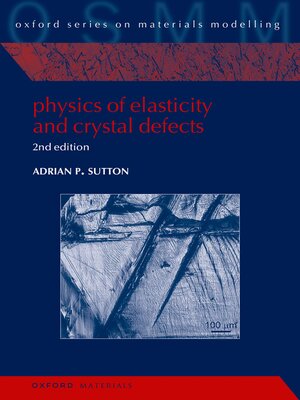Physics of Elasticity and Crystal Defects
ebook ∣ Oxford Series on Materials Modelling
By Adrian P. Sutton

Sign up to save your library
With an OverDrive account, you can save your favorite libraries for at-a-glance information about availability. Find out more about OverDrive accounts.
Find this title in Libby, the library reading app by OverDrive.



Search for a digital library with this title
Title found at these libraries:
| Library Name | Distance |
|---|---|
| Loading... |
Properties of crystalline materials are almost always governed by the defects within them. The ability to shape metals and alloys into girders, furniture, automobiles and medical prostheses stems from the generation, motion and interaction of these defects. Crystal defects are also the agents of chemical changes within crystals, enabling mass transport by diffusion and changes of phase. The distortion of the crystal created by a defect enables it to interact with other defects over distances much greater than the atomic scale. The theory of elasticity is used to describe these interactions. Physics of Elasticity and Crystal Defects, 2nd Edition is an introduction to the theory of elasticity and its application to point defects, dislocations, grain boundaries, inclusions, and cracks. A unique feature of the book is the treatment of the relationship between the atomic structures of defects and their elastic fields. Another unique feature is the last chapter which describes five technologically important areas requiring further fundamental research, with suggestions for possible PhD projects. There are exercises for the student to check their understanding as they work through each chapter with detailed solutions. There are problems set at the end of each chapter, also with detailed solutions. In this second edition the treatment of the Eshelby inclusion has been expanded into a chapter of its own, with complete self-contained derivations of the elastic fields inside and outside the inclusion. This is a textbook for postgraduate students in physics, engineering and materials science. Even students and professionals with some knowledge of elasticity and defects will almost certainly find much that is new to them in this book.







